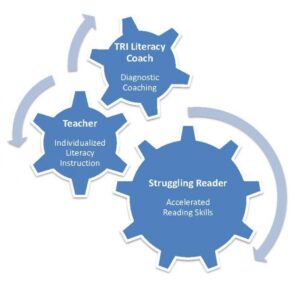 The Targeted Reading Intervention (TRI) professional development program is designed to help kindergarten and first grade teachers in rural, low-wealth schools provide reading instruction for the children in their classrooms who are struggling in learning how to read. University-based literacy coaches provide one-on-one, ongoing support to classroom teachers in multiple states via inexpensive and scalable webcam technology. We began as part of the National Research Center on Rural Education Support, and now continue this research project at the University of North Carolina at Chapel Hill through funding from the Institute of Education Sciences in the U.S. Department of Education.
The Targeted Reading Intervention (TRI) professional development program is designed to help kindergarten and first grade teachers in rural, low-wealth schools provide reading instruction for the children in their classrooms who are struggling in learning how to read. University-based literacy coaches provide one-on-one, ongoing support to classroom teachers in multiple states via inexpensive and scalable webcam technology. We began as part of the National Research Center on Rural Education Support, and now continue this research project at the University of North Carolina at Chapel Hill through funding from the Institute of Education Sciences in the U.S. Department of Education.
The TRI professional development process helps teachers:
- acquire essential knowledge of early reading development and efficient instructional strategies
- develop skills in matching instruction to informal assessment
- apply their learning particularly for the benefit of struggling readers
TRI Teachers work with their struggling readers intensively on a daily basis for about 15 minutes, initially one-on-one and eventually transitioning to very small groups. TRI teachers use diagnostic, evidence-based reading strategies and refine those strategies daily to meet the needs of their struggling readers. TRI Coaches observe TRI lessons weekly via webcam; immediately following the lesson, coaches facilitate a quick conversation with the teacher about the student’s most pressing literacy need. The TRI is both effective and efficient because the strategies integrate multiple, essential early reading abilities in the context of real words and books, and because ongoing coaching enhances a teacher’s diagnostic thinking.
The Targeted Reading Intervention (TRI) is a professional development intervention designed for elementary students who require additional reading instruction and their classroom teachers. Via remote webcam, trained coaches with reading expertise provide one-on-one, ongoing support to build capacity in reading instruction with teachers.
The TRI helps teachers build capacity by:
- Learning and using efficient instructional strategies for early reading development
- Developing skills in matching instruction to assessment
- Applying their learning for the benefit of targeted readers
The TRI has been endorsed by The Annie E. Casey Foundation Blueprints for Healthy Youth Development, The Rand Corporation Promising Practices Network, The What Works Clearinghouse and is included in the Best Evidence Encyclopedia.

 Getting SGP hari ini in the Philippines is no easy task. It requires patience and persistence. In order to achieve success in this, it is important to know where to start, which companies to choose, and the best strategy to apply. Luckily, we have some tips to help you get started.
Getting SGP hari ini in the Philippines is no easy task. It requires patience and persistence. In order to achieve success in this, it is important to know where to start, which companies to choose, and the best strategy to apply. Luckily, we have some tips to help you get started.
 HK Data is a popular word in the world, and if you’re thinking about starting a business in Hong Kong, this word might be something you need to learn more about. In fact, the term “data” is a very popular phrase, and it’s often used to describe everything from business plans to marketing campaigns. But just what is the meaning of “data”?
HK Data is a popular word in the world, and if you’re thinking about starting a business in Hong Kong, this word might be something you need to learn more about. In fact, the term “data” is a very popular phrase, and it’s often used to describe everything from business plans to marketing campaigns. But just what is the meaning of “data”?
 Learning how to play togel HK can be a fun and profitable experience for you. All you need to do is make a small investment and you can earn big prizes that will be transferred directly to your bank account. Best of all, you don’t have to exert a lot of effort or spend your valuable time. Instead, you can sit back and relax, win big and enjoy the ride. Here are a few tips on how to win big in HK.
Learning how to play togel HK can be a fun and profitable experience for you. All you need to do is make a small investment and you can earn big prizes that will be transferred directly to your bank account. Best of all, you don’t have to exert a lot of effort or spend your valuable time. Instead, you can sit back and relax, win big and enjoy the ride. Here are a few tips on how to win big in HK.